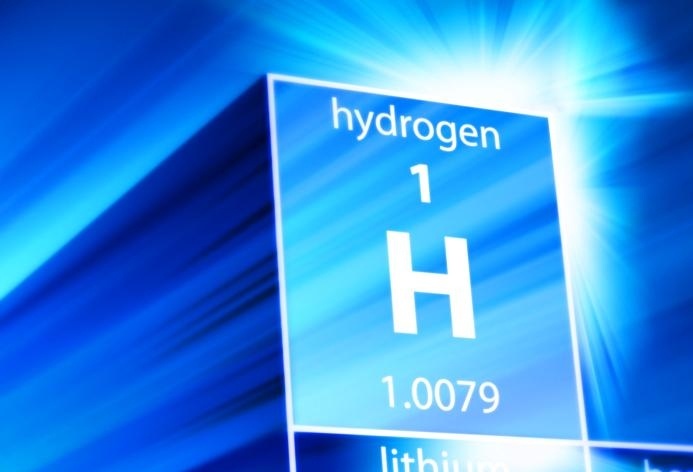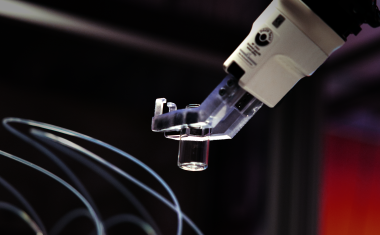Sustainable Hydrogen
If you follow the daily news on climate protection and the promotion of hydrogen technologies, you sometimes get a sense of déjà vu: Didn't this already exist 20 years ago? What was implemented at that time? What sustainable hydrogen-based technologies can we expect today?

As early as the 1990s, the German Research Institute for Air and Space Travel (DLR) - now the German Aerospace Center - was researching on hydrogen projects such as hydrogen production by coupling solar cells with electrolysers in the desert.
BMW already presented the BMW 750i having a hydrogen combustion engine at the Expo 2000. And in the early 2000s Daimler Chrysler also conducted research with Ballard Power on fuel-cell drives for land vehicles that were ready for serial production. In 2002, the first fuel-cell buses from Mercedes-Benz were tested in some major European cities. And a few years ago, Volkswagen acquired patents on Ballard Power's fuel-cell technology. Despite these intensive development activities, hydrogen technology has not yet been able to establish itself in land vehicles.
In contrast, the patented submarines of Thyssenkrupp Marine Systems have been powered by hydrogen for some time. The Class 212 A submarines have been in use with the German Navy since 2004. The innovative propulsion offers considerable advantages over combustion engines, as fuel-cells produce no exhaust gases, only water. In addition, the propulsion is extremely quiet and emits hardly any heat - important properties for so-called stealth submarines.
Sector Coupling and Networks Accelerate Innovation Processes
Today, in 2021, the future of yesteryear is just around the corner. Since 2020, research into the use of hydrogen technologies has been founded even more intensively and also in a much more integrated manner across all sectors of industry by the European Union (EU) via the IPCEI Hydrogen project and nationally by the Federation. The particular focus of the funding will be on sector coupling in order to accelerate the energy revolution and implement penetration of the market. The declared objective is to reduce greenhouse gas emissions in the EU.
In this holistic approach, sector coupling of energy-intensive industries such as chemistry and steel is intended to catalyze the application of hydrogen technologies in all areas of industry and life. For example, surplus electricity from renewable energies may be converted into hydrogen and oxygen. Oxygen may be used in local sewage treatment plants, while hydrogen is used to generate energy.
The Namosyn consortium, which includes universities, Fraunhofer institutes, industrial companies and the Dechema, is researching the entire value-added chain of production and use of synthetic fuels from hydrogen, from synthesis, plant and engine construction to the automobile.
The chemical industry is conducting research on the conversion of hydrogen and CO2 into methane as well as of hydrogen into basic chemicals such as dimethyl ether in industrial-scale or also by microbial processes. In other projects, the conversion of metallurgical gases and hydrogen into monomers for plastics, fertilizers and other valuable materials is being investigated.
As soon as green hydrogen will affordably be available in large quantities and the hydrogen filling station network will be sufficiently developed, a significant increase in the number of fuel-cell vehicles can be hoped for. The companies Air Liquide, Daimler, Linde, OMV, Shell and Total have joined forces in the H2 Mobility and have already taken more than 120 hydrogen filling stations into operation all over Europe. The company is advised and supported by the associated partners BMW, Honda, Hyundai, Toyota and Volkswagen, as well as by the company NOW, the founding mission of which is the National Hydrogen and Fuel Cell Technology Innovation Programme.
The required infrastructure for distribution of the hydrogen is starting to arise. Just recently, a letter of intent for the transport of hydrogen-to-hydrogen filling stations between Nikola and Iveco and the transmission system operator OGE (Open Grid Europe) was announced. And the energy service and infrastructure provider Westenergie is testing whether existing natural gas distribution networks may be used to transport hydrogen to end users. In the commune of Holzwickede near Dortmund, the company is switching an existing natural gas pipeline of public gas supply to pure hydrogen for the first time in Germany. "If the test is successful, Germany could use its great advantage for the energy system of the future: We could use our well-equipped natural gas network having a length of more than 550,000 km for hydrogen. This would have both ecological and economic benefits," says Katherina Reiche, CEO of Westenergie and chair of the National Hydrogen Council.
Patent Hydrogen Technologies
If the innovation efforts of companies were correlated via the number of their patent applications in the field of hydrogen technologies, the various sectors of industry would perform very differently.
Thus, the innovative strength of the chemical industry or, e.g., of the oil company Shell is demonstrated by the number of patent applications relating to hydrogen technologies, already since the beginning of the 2000s. Shell researches very intensively in all fields of hydrogen use and protects its development results extensively via patents. Also the technology group Siemens Energy is conceiving hydrogen technologies as key technologies for sector coupling of the energy sector and the chemical industry and is intensively developing them. This is shown by the enormous number of patent applications filed in recent decades.
Currently, steel manufacturers throughout Europe are developing plants and processes for direct reduction of iron ore with hydrogen for the production of pig iron. This development activity is not yet reflected in the number of pending patent applications. However, patent applications are only published after a period of 18 months form the filing date.
Thyssenkrupp is developing a process for chemical conversion of metallurgical gases from steel production with the additional use of hydrogen to produce basic chemicals under the trademark Carbon2Chem. "For us in industry, hydrogen technologies are the key to climate neutrality. Hydrogen can replace carbon as a reducing agent in steel production and thus avoid CO2 emissions. In addition, we can also use CO2 emissions as raw material: those that cannot be directly avoided in steel production, but also in other sectors such as the cement or lime industry and in waste incineration plants. We process them into basic chemicals and thus replace fossil raw materials in the chemical industry. Carbon2Chem thus makes an important contribution to recycling economy and sector coupling," explains Markus Oles, one of the three responsible overall coordinators at Carbon2Chem, on the importance of hydrogen technology for Thyssenkrupp Steel Europe. "To meet the large needs, we are working with various partners already now on projects to develop hydrogen supply," adds Oles.
Thus, e.g., a building block of hydrogen production for green steel production is being set up in Lingen as part of the Hydrogen Initiative GET H2. The objective of the GET H2 partners BP, Evonik, Nowega, OGE and RWE Generation is to build up the first publicly accessible hydrogen infrastructure. The patent applications resulting from this infrastructure initiative will point up the innovative and successful cooperation of European industry in sector coupling, also in the topic of innovation protection.
Among original electricity companies, the number of patent applications in the hydrogen sector is significantly lower. And also among German automobile manufacturers, the internal weighting of the technology can also be seen in the weighting of patent applications for "fuel-cells" and "hydrogen". The Asian automobile manufacturers Toyota and Hyundai and also Chinese car companies have a completely more innovative position with their hydrogen-powered vehicles protected by various patent families.
The European Patent Office (EPO) has been publishing cross-sectoral information on companies and inventors of patented sustainable technologies, i.e. in green transportation, energy production and energy storage. The current cross-sectoral funding of hydrogen technologies by the EU and the German government, which also comprises CO2 conversion - defossilization - such as the production of monomers for the plastics industry and of synthetic fuels, besides the use of hydrogen in mobility, has catalyzed innovative strength in Europe once again. Recently, European courts have further increased the implementation pressure on stakeholders.
The sum of all these efforts and innovations leads us to highly anticipate a decade of innovation for hydrogen technologies and green technologies in general in all areas of industry and life in Europe.
Authors: Tanja Bendele, Anna Katharina Heide, Ruhr IP Patent Attorneys

Personal Profile: Tanja Bendele
is founding partner of RuhrIP Patent Attorneys and heads the departments of chemistry, pharmaceuti-cals including life sciences, medical technology, 3D technology and process engineering. She holds a doctorate in chemistry and is a German and European Patent Attorney. She is currently studying E-Technology. Since 2020, she has been a member of the Patent and Utility Model Committee of the German Chamber of Patent Attorneys and has been a board member of the German Association for the Protection of Intellectual Property and Copyright (GRUR), District Group West.
© Ruhr-IP Patentanwälte

Personal Profile: Anna Katharina Heide
is heading patent attorney in the department of life sciences/ biotech of RuhrIP Patent Attorneys. She is a German Patent Attorney as well as a European Patent, Design and Trademark Attorney and represents internationally established companies in the life sciences sector (including biotech and diagnostics). One of her main areas of practice is interdisciplinary technologies. She holds a doctorate in biology and has been Vice-Chair of the Biotechnology Committee of the German Chamber of Patent Attorneys since 2020.
© Ruhr-IP

















